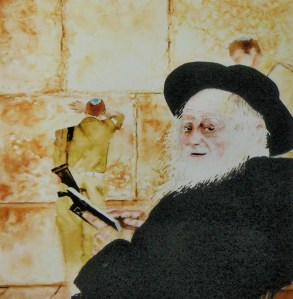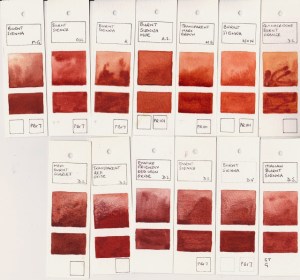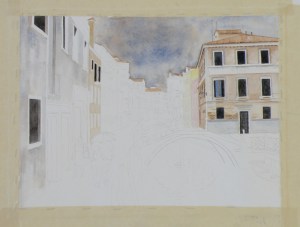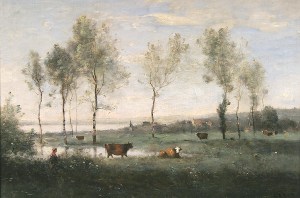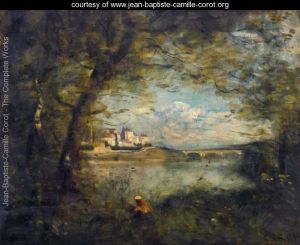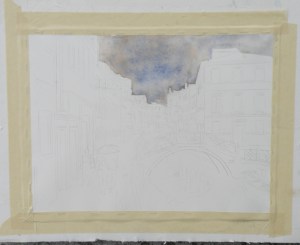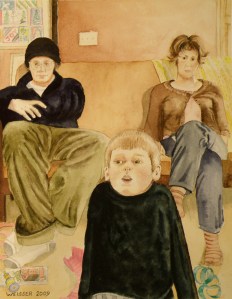When one reads about the long life of Jean Sibelius and how he had such a strong affinity for nature, for Autumn and Winter in particular, and was, after all, a Finn, whose country embraces the colder months, it seemed fitting to depict Sibelius Square in November. His biographer wrote this:
“. . . Even by Nordic standards, Sibelius responded with exceptional intensity to the moods of nature and the changes in the seasons: he scanned the skies with his binoculars for the geese flying over the lake ice, listened to the screech of the cranes, and heard the cries of the curlew echo over the marshy grounds just below Ainola [his home, named after his wife]. He savoured the spring blossoms every bit as much as he did autumnal scents and colours. . . “
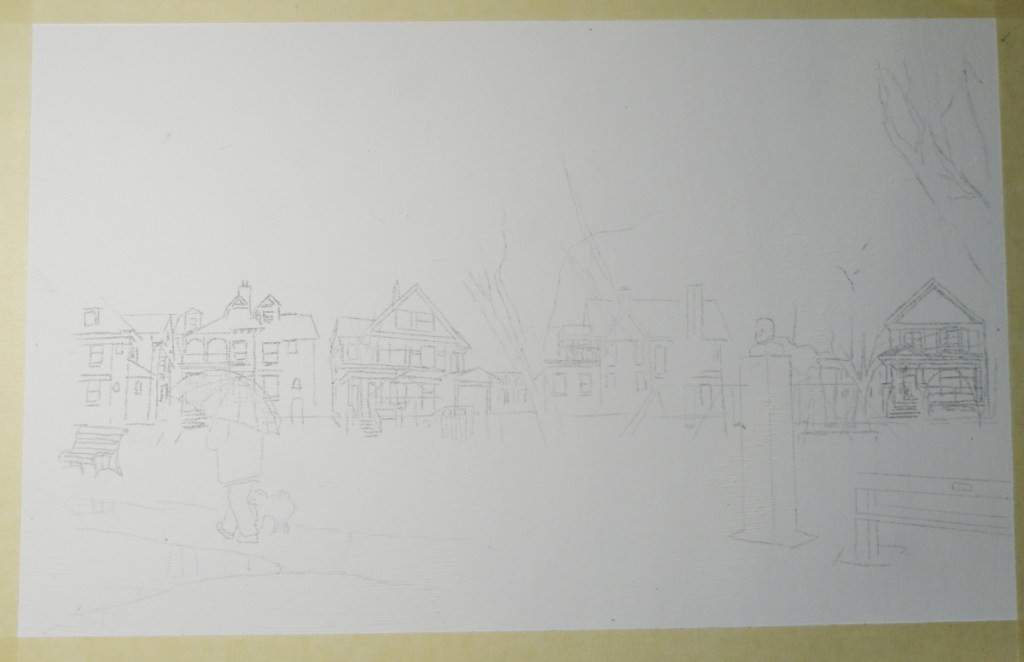
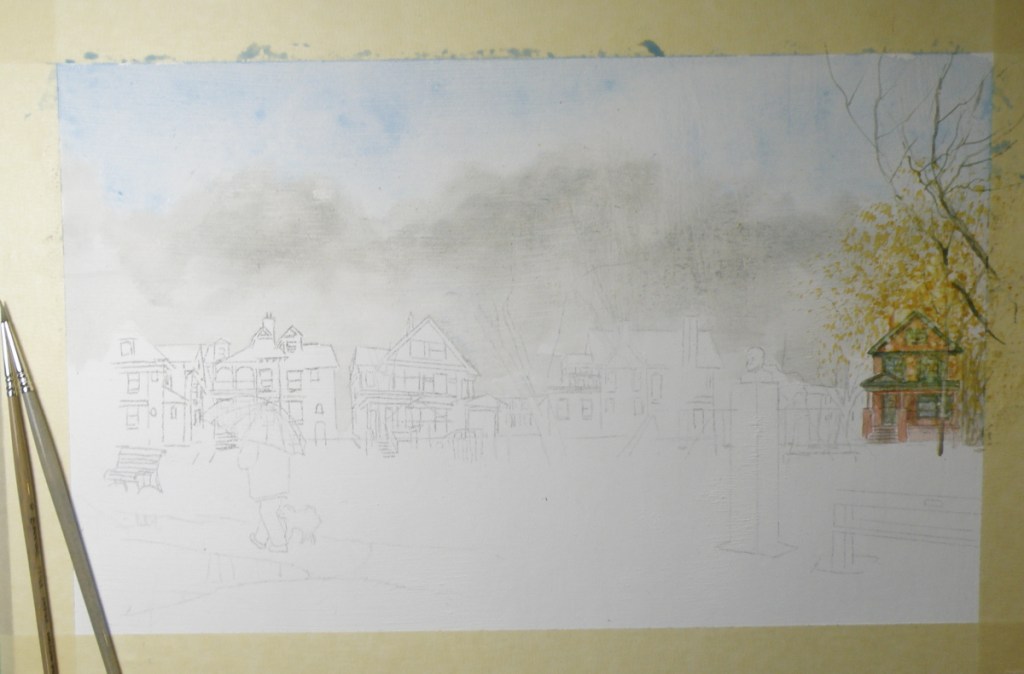

The distinctive, late 19th c. Toronto architecture of the area known as The Annex is unabashedly Victorian, boasting ‘some of the largest collection of Victorian houses in North America.’
‘During this period Toronto also developed some unique styles of housing. The bay-and-gable house was a simple and cost effective design that also aped the elegance of Victorian mansions. Built of the abundant red brick, the design was also well suited to the narrow lots of Toronto.’ [wikipedia: The Architecture of Toronto]

In The Annex, however, there was an elegance reserved only for those who could afford it. ‘Built by the city’s wealthy and mostly found in the neighbourhood they are named after, these houses contain diverse and eclectic elements borrowed from dozens of different styles. These houses are built of a mix of brick and sandstone, turrets, domes, and other ornamentation abound.’ [ibid.]

In this painting, some decisions had to be made as to whether it was going to be about the houses surrounding The Jean Sibelius Square Park, or about the monument dedicated to the composer, or about the overall mood of late Autumn and how it informs the architecture, the park and what Sibelius himself loved about November.
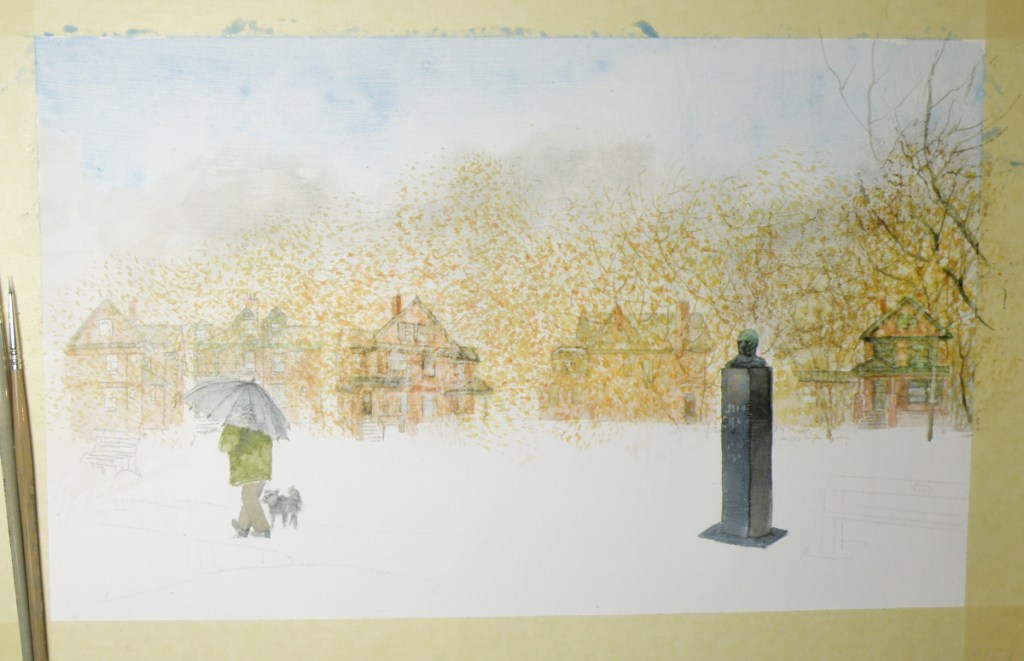
Western Wall
January 31, 2020
I’m not much of a traveller. Outside of Canada and 45 U.S. States, I’ve visited Taiwan, The Philippines, and Israel. In 1990, the regional tensions were at an uneasy rest and we were able to go all through areas like The West Bank, Gaza, and the Golan Heights.
It is geographically and culturally stunning. Some places are visited for their beaches, their ability to bring an almost somnambulant quality, where rest and relaxation are a given. Israel offers endless contrasts, confrontation, challenge and comparison. I doubt anyone can go and have their presuppositions confirmed. I am quite sure everyone who leaves, leaves changed.
I have never been so moved by a place and a people as I was in Israel.
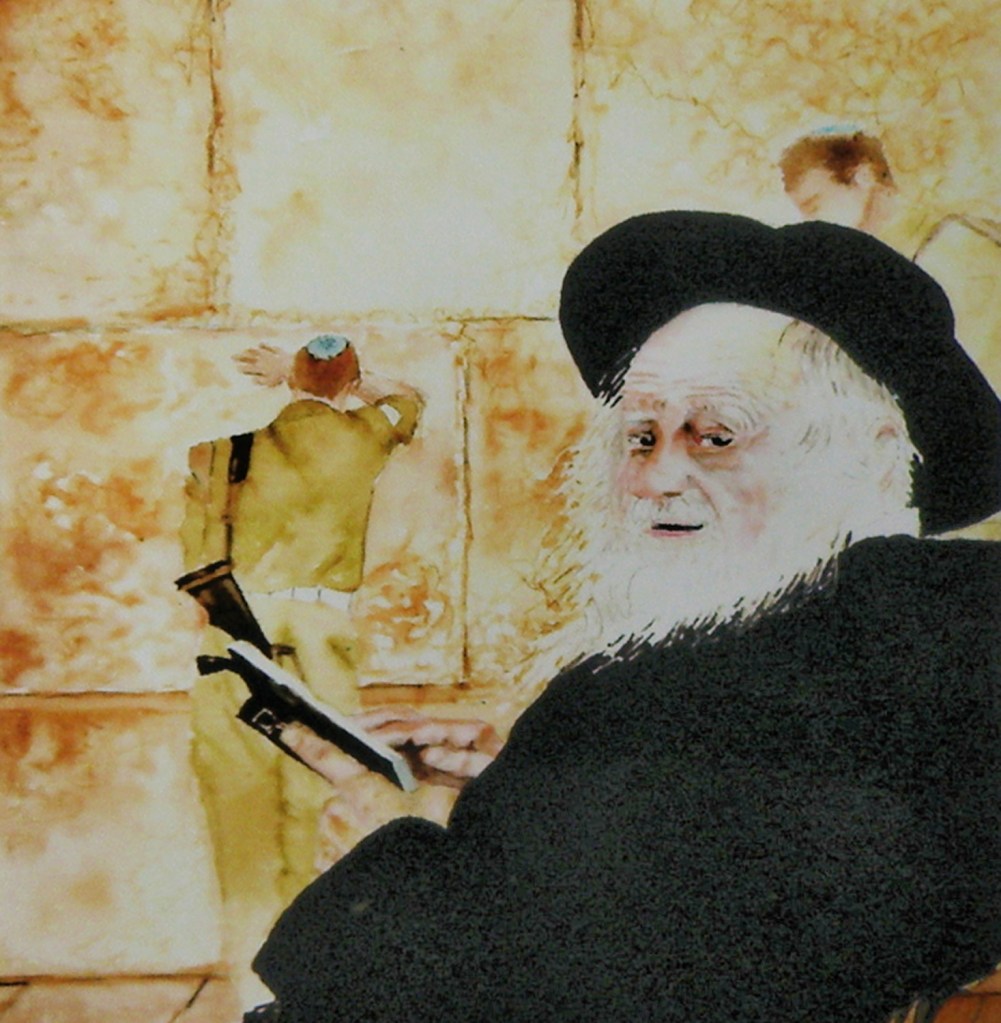
watercolour on Arches Cold Press 140# Paper
by Lance Weisser
12″ x 16″
SOLD
Murtle Lake November
December 30, 2019
Murtle Lake–housed within the gorgeous Wells Grey Provincial Park–about an hour’s drive from our home in Kamloops, B. C.–“is world-famous as the largest canoe-only lake in North America. Set in a pristine mountain valley, the north and west arms are approximately 20 km long, and the lake averages three kilometres wide. . . ” [http://www.env.gov.bc.ca/bcparks/explore/parkpgs/wg_murt/]
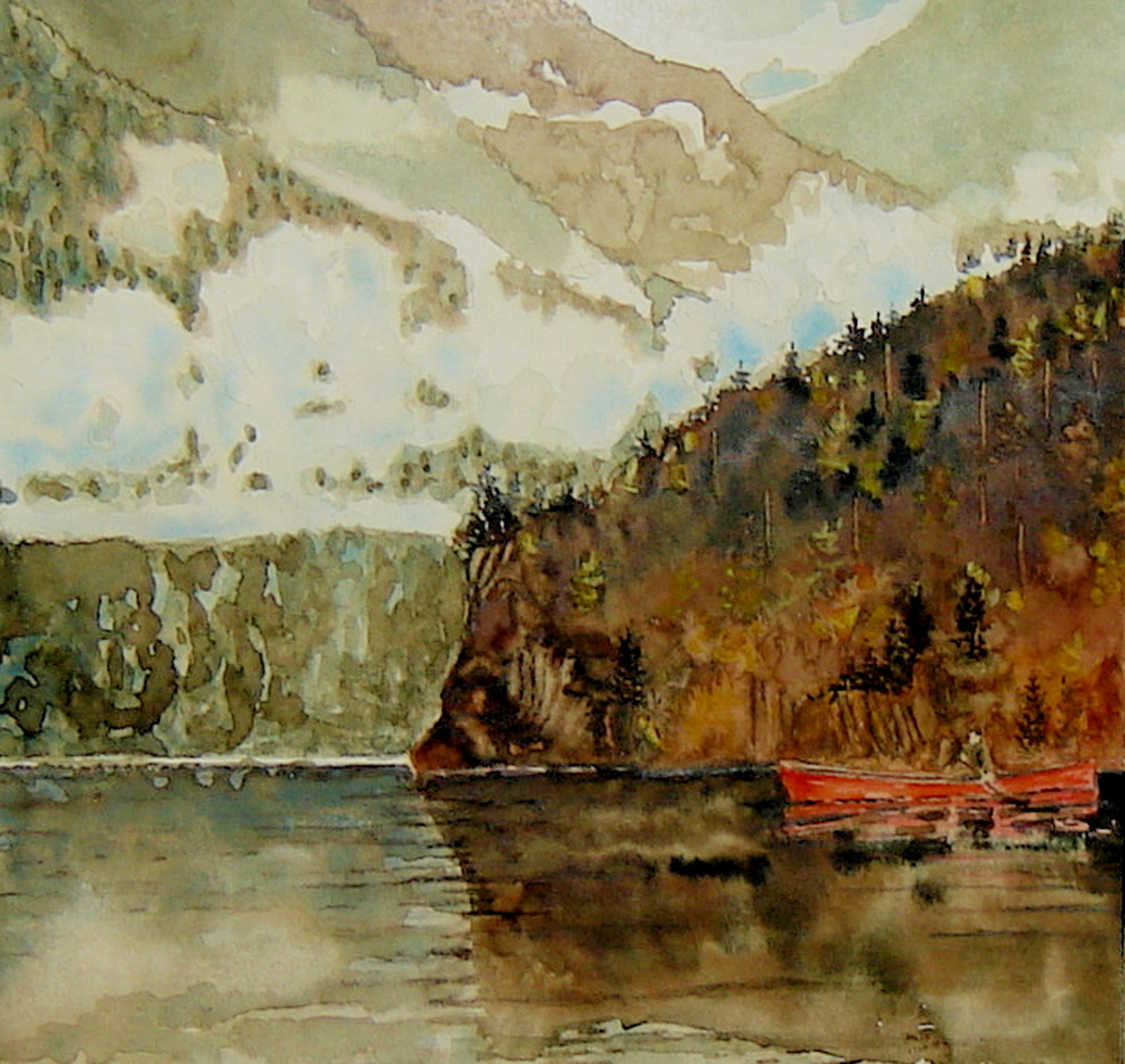
watercolour by Lance Weisser
140# Arches Cold Press Paper [sold]
On the Wells Grey Provincial Park website comes this advice to those who wish to access Murtle Lake for overnight canoe/kayaking trips:
“The outlet of Murtle Lake is the swift-flowing and dangerous Murtle River, noted for its many waterfalls. Visitors wishing to hike to McDougall Falls must use caution in Diamond Lagoon.”
“Murtle Lake is a large lake and subject to gusts of strong wind. The lake often becomes choppy in the afternoon. If moving camp it is best to do so in the forenoon. Never try to out-run a storm; beach at the first available opportunity and wait out bad weather. The Park Operator has emergency communication and a satellite phone link located in the Ranger Cabin on the south shore of Murtle Lake.”
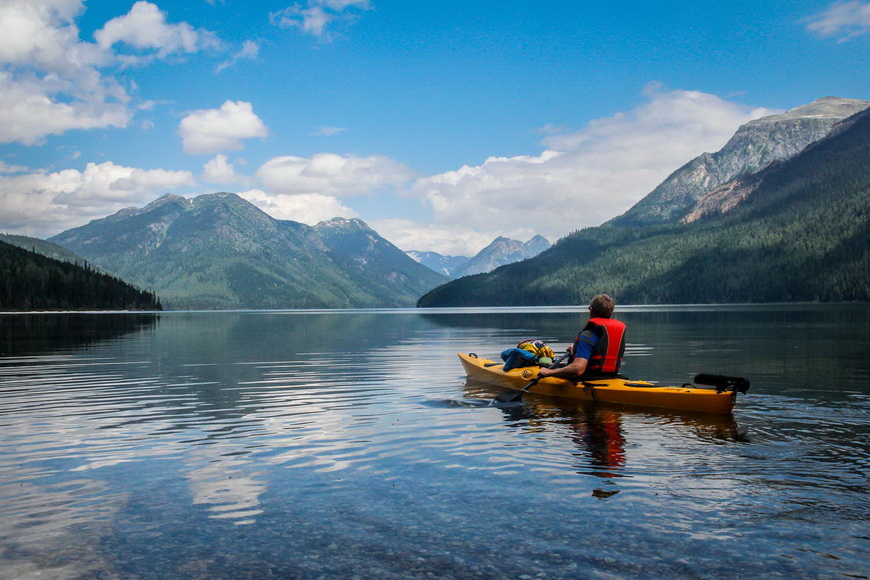
Winter Corn
February 26, 2019
Yes, it is probably apparent by now that I have an ongoing fascination with Ravens. I’m not alone. There’s a woman in the historic house section of our city of Kamloops not-so-affectionately known by her neighbours as ‘the crow lady’, whom I depicted in an earlier post entitled ‘Where The Heart Is’:

She is known as ‘the crow lady’ because starting in late autumn and all through the ensuing winter, ‘crow lady’ fills a number of her vintage bird baths with cat kibble as corvid bird food. Her historic home then becomes wreathed in a continuous flight of ascending and descending crows, ravens, and starlings, and their distinctive din of calls and caws as they attack her bird baths.
I do believe there’s even a by-law ‘crow lady’ continuously violates, but it doesn’t seem to dint her enthusiasm for ensuring her lovely noisey visitors are kept fed and satisfied.
In tribute to my friend Joan (aka ‘crow lady’), I offer up today’s honouring of local ravens, these few trying their best to find themselves a few kernels of corn.
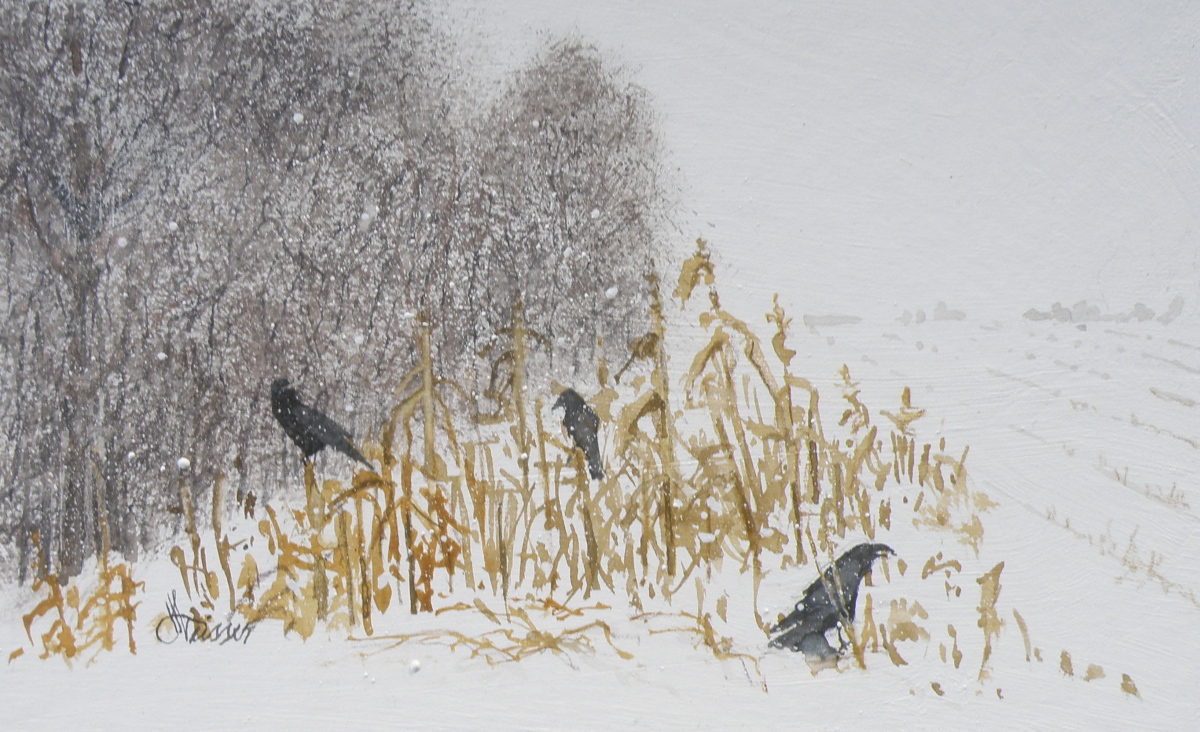
No doubt when they’re through scratching away here, they’ll give up and head over to Joan’s.
where the heart is
March 24, 2018
Our city, Kamloops, B. C., is a native word meaning ‘the joining of rivers’ (where the North and South Thompson meet), and was founded by the Hudson Bay Co. in 1812. As it grew and developed it became a railroad city (one of two cities in Canada where both CN and CP intersect). The most gentrified residences are found on St. Paul Street, where many bear historical plaques for passers-by to read and gain knowledge of.
Turn of the Century–c1904–homes are difficult to maintain and keep in tiptop condition, as many reading this can appreciate. Keeping up any house is expensive and challenging.
I befriended a woman who has outlived her spouse and is just able to keep the basics going while having to block off the upstairs from heat in the Winter. Budgeting simply to stay put and keep living in her beloved heritage house before facing the inevitable and dreaded ‘downsizing’, her joy is feeding Crows, Ravens and Starlings using cat kibble poured into oversized vintage bird baths. This certainly doesn’t make her the darling of her neighbours, but has earned her the moniker ‘the crow lady’.
She’s never seen this painting because I fear it may upset her, yet it was painted with affection and as a tribute to her intrepid spirit and unwillingness to let go of that which she dearly and completely loves:

‘Where the Heart Is’
watercolour on Arches 140 lb Hot Press Paper, 12″ x 16″, collection of J. Weisser
שַחֲרִית Shacharit — Morning Prayer
August 27, 2015
In January of 1990 I had the privilege of going on a tour of Israel conducted by an outstanding Orthodox guide named Joe, who was so completely well-versed in history and biblical understanding that archaeological sites acquired lively, humanized detail under his well-studied knowledge of what we believe took place there.
Though he was conducting about a dozen clergy, he was able to draw comparison between traditions which were tied to ha aretz (הארץ), to the land, helping us see the visceral, physical connections we’d only tried to understand through having read the ancient texts and stories.
‘Western Wall Shacharit’
watercolour on Arches Hot Press 140# Paper, 10″ x 15″, sold
The Western Wall is almost certainly the most revered of all sites in Israel, as it physically connects worshipers to those before them who also had to struggle to build a homeland–who also had to appeal to that higher power to protect and defend them.
I felt privileged to have been able to see Israel at a time when the intifada was at a standstill and veritably every location in the country was accessible and security was more relaxed. We could travel the Golan Heights as well as the West Bank, stand at the Lebanese border and visit the historic cities and towns throughout the land.
…this is a repost from an entry several years ago
venice challenge 3
August 14, 2015
It is so affirming when blogging friends don’t find details about paint pigments and their sedimentation arcane. One can easily picture guests around a table nodding-off face-first into their creme-brulee.
In the Renaissance, clay earth from Siena, Tuscany, (Terra di Siena, “Siena ground”) rich in iron oxide and manganese oxide was used for pigments. In its natural state, is a yellowish clay, and becomes raw sienna as a pigment. When heated up, it turns reddish brown and becomes burnt sienna.
However, due to its being heated up, there is a variety of watercolour burnt sienna shades and hues among the various manufacturers because some heat it a little more, some a little less, making it somewhat more or less ‘burnt’.
http://janeblundellart.blogspot.com.au/2013/11/watercolour-comparisons-4-burnt-sienna.html
Ultramarine and burnt sienna will be the two colours for the whole piece with the exception of a bit of Rose Madder and Quin Gold for the more distant buildings. Doing so (almost) guarantees integration. That is because a viewer’s eye will find a colour harmony whenever the pallet is limited, as no one colour or tone will be glaringly different from the rest.
stage two
Focal points are achieved in limited-pallet paintings through value contrast (the dark windows against the lighter walls), rather than by there being a glaringly-different colour thrown in. That said, some of the early masters used a glaringly-different colour to great visual effect, as in Corot, whose ‘signature’ accent was the use of a dash of scarlet in an otherwise integrated landscape….
JEAN-BAPTISTE-CAMILLE COROT (1796 – 1875)
(sources for ‘burnt sienna’ from Jane Blundell and Wikipedia)
venice challenge 2
August 12, 2015
The ongoing quest to interpret in watercolour a photo of Venice by Frank Dwyer of our local Kamloops Photo Arts Club has begun to take shape with a decision to take this 11.5cm x 16.5cm image and paint it as bigger–28cm x 25.5cm (11″ x 14″) –simply because a miniature of such a complex scene might prove less successful.
So here goes….
As much as the photo (entitled ‘The Blue Umbrella’) reveals damp pavement and the umbrella-holding couple, the sky isn’t quite as rainy-looking as perhaps it can be made to be for artistic interpretation purposes. So ultramarine blue and burnt sienna were applied to the whole of the sky as a wash.
Ultramarine Blue has a nice quality of being one of the ‘granulating’ pigments of watercolour. Its origins stem from the grinding of lapis lazuli, and received its name from the Latin ‘ultramarinus’ (meaning ‘beyond the sea’) .
So treasured and prized by the early painters, ground lapis (from Afghanistan, principally) was used by the painters of early icons as the garments for The Blessed Virgin. (When The Holy Mother is depicted, her robes are red.)
In 1826 a synthetic version was created which itself derives from a mineral compound, lazurite, and is today the most complex of all pigments. Being a ground mineral, ultramarine produces sediment that dries in a granular way when mixed with water.
To get this effect, however, the painter must apply ultramarine as a wash so the sediment can, in fact, separate and settle to create granulization. That is why, then, the sky dropped into the first stage of the painting appears granulated and gives a kind of antique look. If ultramarine is applied with only a bit of water, or straight from the tube (yikes), it will not granulate as such.
Some watercolourists are so avid about granulization, they buy a granulating medium from Daniel Smith, which, when mixed with most any watercolour paint, granulates. However, the natural granulating pigments are raw umber, burnt umber, raw sienna, and some brands of burnt sienna. That is because they come from the earth, and earth leaves sediment.
All of this material comes from a variety of sources, including http://janeblundellart.blogspot.com.au/ — (a very thorough and devoted watercolourist from Australia).
Great Nephew II
January 17, 2012
About the scariest thing in my younger days was our basement, which featured a gigantic coal-fed furnace complete with horrifying facial qualities. The grill was its mouth, and I went down there only to fling my soggy snowsuit over one of its tentacle arms in order to then put on a freshly-dried suit. Once done, I’d try not to peek at the flames licking at the hideous mouth as I raced back out into the snowball fight du jour.
Tied for second in the scary department was the black-and-white-filmed 1951 classic “A Christmas Carol” starring Alistair Sim, (whose facial qualities were probably borrowed by the designer of the furnace grill). It was back then a relatively new movie and always gave me recurring nightmares.
I happened to be taking a few snapshots when the older of my two Great Nephews was watching that very same 1951 “A Christmas Carol’ in 2006. Up till then he wasn’t allowed to see it (which restriction I wish my own parents had imposed on me), so this was his very first glimpse at Jacob Marley screaming his way through Scrooge’s bed chamber walls.
His Aunt and Uncle are obviously ‘Christmas Carol’ vets, regarding the shrieking spirit as ‘just an undigested bit of beef’.
This painting was juried into one of The Federation of Canadian Artists’ Open Shows a couple of years ago. The words ‘Open Show’ indicates that the show is open to all qualifying artists across Canada.
